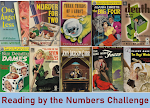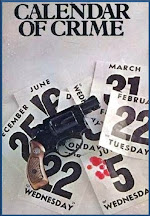 Stag Dinner Death (1983) by John Penn (pen name of husband & wife team Jack H. Trotman & Palma Harcourt)
Stag Dinner Death (1983) by John Penn (pen name of husband & wife team Jack H. Trotman & Palma Harcourt)The very posh backroom of a gentleman's club is one of the last places you'd expect a pregnant woman to spring a scandal...but that's what Sally-Ann Belmont does. Earlier in the day, she stops by the practice of Dr. John Breland, a young doctor who has set himself up with a lucrative Harley Street type practice. She wangles a last-minute appointment by claiming to be a friend of Breland's friend Gerald Hinton. Her complaint? Vague discomfort cum pain associated with her pregnancy. Breland can't find any definite cause and asks for her regular doctor's name and address so he can send along what notes he has. She produces the information with some reluctance and, once she's gone, Breland who is the suspicious sort asks his nurse to look the doctor up. He doesn't exist.
The next glimpse we get of Sally-Ann is when she makes a grand theatrical entrance at Hinton's stag party where he's celebrating his forthcoming wedding to the very lovely Elizabeth Lydney. Sally-Ann announces that she's pregnant and Hinton is the father. She swears vengeance for his dumping her and disappears. A stunned Gerald, who swears he's never seen the woman before, follows in pursuit but can't find her. A few hours later, the body of the club's ladies'-room attendant is found and then Sally-Ann is also found murdered some days later, though the autopsy reveals that she was also killed on the night of the stag party.
Was Gerald really daft enough to kill these women directly after the announcement when his motive would be so glaringly obvious? Would he really kill to try to cover up a paternity suit scandal? The police focus their investigative spotlight on him, but they don't seem to think he fits the bill. Breland, who knows Gerald rather well, definitely doesn't think so and starts to dig for alternatives. He discovers that two of the club's members did know Sally-Ann very well. Well enough that they might have needed to keep her from spilling their beans along with her announcement about Gerald. Elizabeth's cousin, who had hopes of marrying her himself, could--just possibly--have arranged a hoax to frame Gerald. Or is there a sinister Mr. X directing things? Breland remembers a conversation and that sets him on the right track. But will he be able to prevent a third murder...possibly his own?
It's been about 25 years or so since I read my first John Penn novel (and their first novel as well, An Ad for Murder). I did enjoy that one quite a bit, though, and promptly put Penn down as one of the authors to look for. It was a long time before I found any more of the books. Stag Dinner Death is an entertaining little puzzle from the post-Golden Age period where fair play isn't quite as important. There are a few clues that don't get displayed, but Breland is a charming amateur detective and it is fun to watch him go to work to clear the name of his friend. I did guess the culprit--but without those vital clues (that are only displayed at the end) I wouldn't have been able to prove it. A very pleasant day's read and I look forward to the others I've managed to find. ★★★
[Finished on 9/26/17]
********************
Fulfills the "Bird" category on the Silver Vintage Scavenger Hunt card.






















































